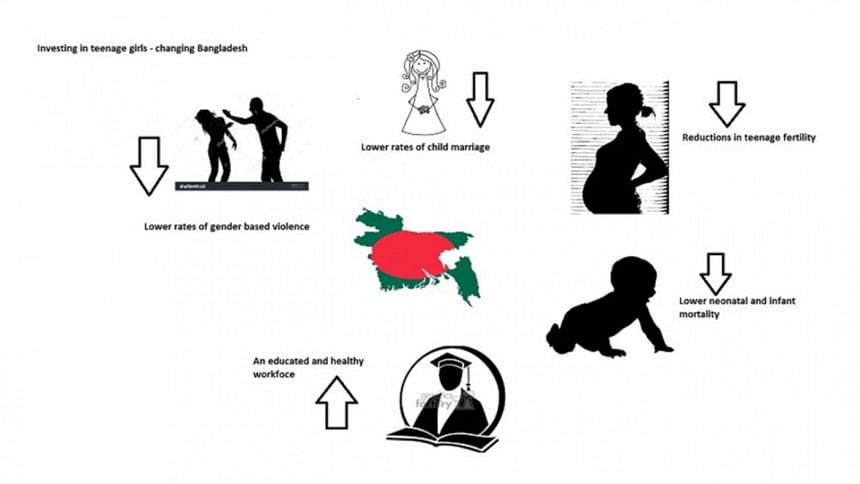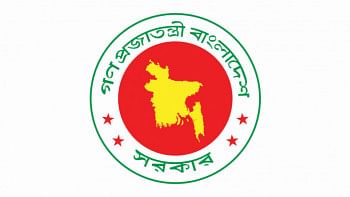Investing in Teenage Girls

Why teenage girls?
'Invest in girls, change the world!', 'Educate a girl, educate a nation!', 'Want to change the world? Invest in a teenage girl' or some variation of this maxim has been proclaimed in the development sector for decades. Despite the recognition that investing in teenage girls will not only improve their lives but also ensure the achievement of key development goals, very few countries have made concerted efforts to focus on teenage girls. It is however evident that teenage girls around the world face more and greater challenges than their male counterparts. In many countries, including Bangladesh, when a girl reaches puberty, her family and community deems she is ready for marriage, pregnancy and childbirth, responsibilities she innocently takes on often with devastating consequences for herself, her child, family and society as a whole.
Recommendations* Family, social and legal systems to ensure the protection of adolescent girls; |
Agenda 2030 and teenagers
Fortunately, we now see a stronger global consensus on the need and benefits of focusingon teenagers and especially teenage girls'education, health and social welfare. This consensus is expressly reflected on Goals 3, 4, 5 and 8 of Agenda 2030. UNFPA's Executive Director, Dr Babtunde Osotimehin refers to the call made by Agenda 2030 to leave no one behind and says “To reach those furthest behind, leaders and communities must focus on and stand up for the human rights of the most marginalized teenage girls, particularly those who are poor, out of school, exploited, or subjected to harmful traditional practices, including child marriage. Marginalized girls are vulnerable to poor reproductive health and more likely to become mothers while still children themselves. They have a right to understand and control their own bodies and shape their own lives.”
It is in recognition of the importance of investing in young people, and most especially teenage girls, that UNFPA selected this theme for World Population Day 2016.
Teenage girls in Bangladesh
How can Bangladesh translate the SDGs' call to invest in adolescent girls, into action? Often heralded as a role model for the impressive achievements in maternal and child health, poverty reduction and gender parity at primary education, how will the country now reinvent itself to run the last mile to tackle the remaining, persistent challenges:
* About 59 percent of women aged 20-24 marry before they turn 18.
* Bangladesh has the world's highest teenage fertility rate outside of Africa. About 31 percent of adolescents aged 15-19 are already mothers or pregnant with their first child. Next only to Turkmenistan, Bangladesh has the youngest mean age of childbearing of any country in the world.
* Early childbearing lengthens the reproductive period and subsequently increases fertility. In many countries postponement of first births- reflecting an increase in the age of marriage- has contributed greatly to overall fertility decline.
* Early childbearing also tends to restrict educational and economic opportunities for women.
* Use of Family Planning (FP) methods before the birth of the first child among married adolescent girls remains low. Despite having the higher unmet need for FP, only 51 percent of 15-19-year-olds are using a FP method, below the national average at 62 percent.
Adolescents between the ages of 10 and 19 years, account for 36 million or 22% of the total population. Of these, approximately 18 million are adolescent girls (BBS 2015). This number has reached a peak in 2016 making this the ideal time for investments, as the health and education of today's teenage girls are the determinants of tomorrow's economic and social development. While there might be some, albeit unjustifiable, reluctance to allocate adequate resources for quality education given that the lasting benefits are only visible a decade later, literature suggests that investments in health, including sexual and reproductive health, translate almost immediately in benefits in the form of less absenteeism, higher productivity at work, in school and at home.
What Does it mean to Invest in Teenage Girls?
It is primarily a paradigm shift in approaches to budgeting: national budgets mustbe gender responsive and prioritize investments that bring long-term returns. These investments include:
Keeping the teenage girl at the centre
Given the right investments, what can Bangladesh look forward to?
Even more or equally important as having policies and strategies, investing in Girls will necessitate implementation, monitoring and evaluation of these policies and strategies; turningrhetoric into action. For this to be effective, there is critical need of Data that is age and sex disaggregated, reliable, timely, developmentally relevant, and down to the lowest possible level. Ideally, this data will allow comparisons over time and tracking of inequalities within and between countries.
Today's Adolescent is the Adult of tomorrow. Bangladesh will be better off with a twenty-five year old woman who is educated, healthy and engaged in decent employment. A young woman with access to family planning who freely and consciously chooses if, when, the spacing and the number of her children. A woman who will ensure the well-being of her family while meaningful and proudly contributing to the overall development of her Country.
It makes logical, economic and human rights' sense to Invest in Teenage Girls!

 For all latest news, follow The Daily Star's Google News channel.
For all latest news, follow The Daily Star's Google News channel. 



Comments